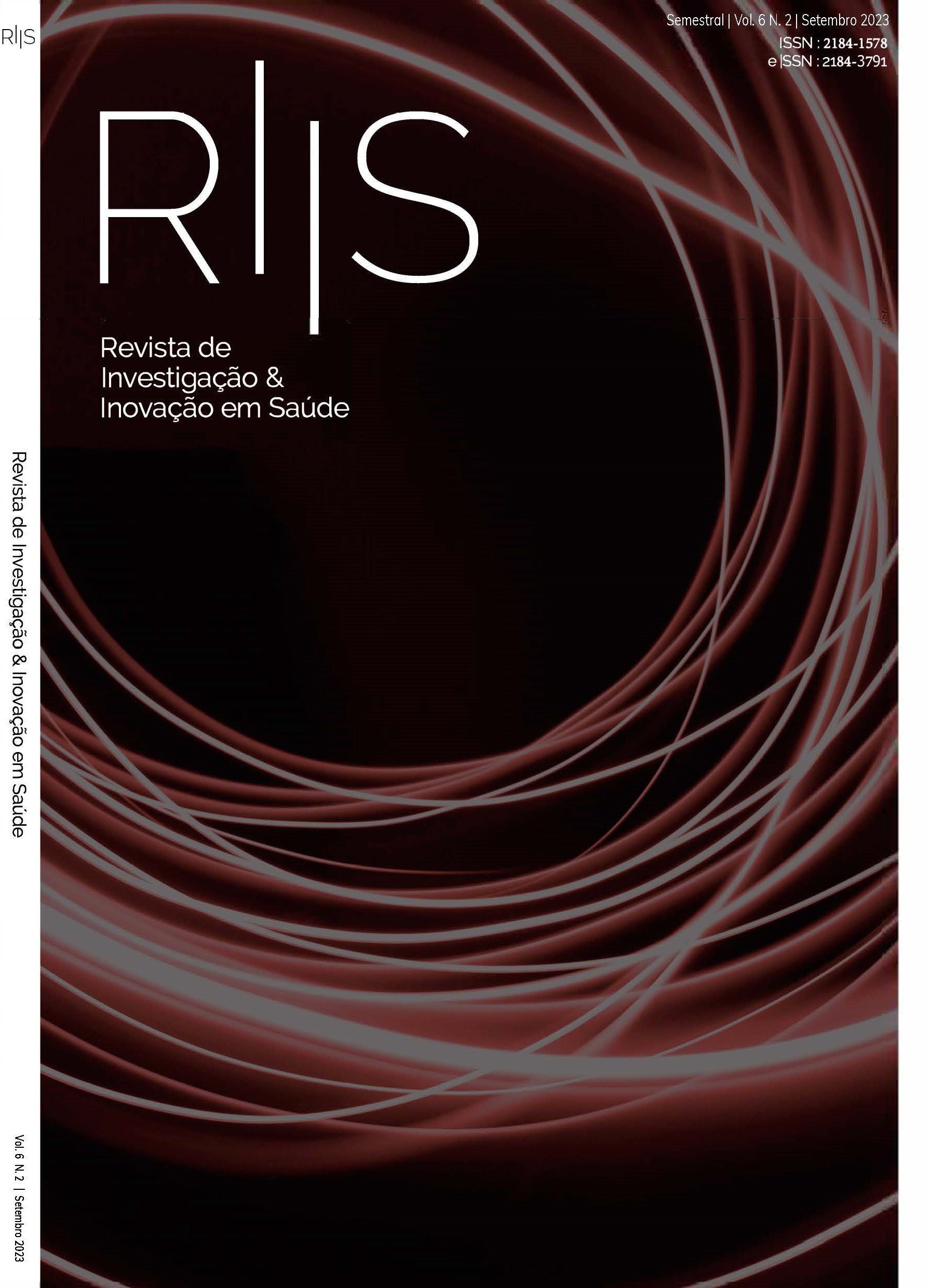The effectiveness of high-flow nasal oxygen in respiratory insufficiency: systematic review
DOI:
https://doi.org/10.37914/riis.v6i2.235Abstract
Background: respiratory insufficiency is a syndrome with a great impact on hospital admissions, morbidity and mortality. The applicability of High-flow nasal oxygen has been the subject of interest in critically ill patients. Objective: to know the effectiveness of High-flow nasal oxygen as a treatment for respiratory insufficiency in adult patients admitted to the intensive care units. Methods: systematic reviews of effectiveness using the PICO strategy and recommendations from the Joanna Briggs Institute. The survey was carried out in august 2021 using the PubMed and EBSCOhost access platforms. Results: 583 results were identified. Six randomized clinical trials were analyzed. The selection was made after elimination of duplicates; title reading, abstract reading and full text reading according to the Preferred Reporting Items for Systematic Reviews and Meta-Analyses diagram. Conclusion: high-flow nasal oxygen proved to be comfortable, tolerable and effective in the treatment of hypoxemic and hypercapnic respiratory insufficiency. It was effective when compared with conventional oxygen therapy in the post-extubation of hypoxemic patients and in reducing partial pressure of carbon dioxide when compared with Non-Invasive Ventilation in hypercapnic patients.
References
Gomes, A. J., Ramos, S., Vieira, C., Pinho, A., Rego, A., & Macedo A.P. (2021). . The Effectiveness of high-flow oxygen in the respiratory insufficiency: Systematic review. PROSPERO CRD42021271482. https://www.crd.york.ac.uk/prospero/display_record.php?ID=CRD42021271482
Aromataris, E., & Munn, Z. (2020a). Chapter 1: JBI Systematic Reviews. In: Aromataris E., Munn Z. Editor. JBI Manual for Evidence Synthesis. https://doi.org/10.46658/JBIMES-20-02 DOI: https://doi.org/10.46658/JBIRM-17-01
Aromataris, E., Munn, Z. (Eds) (2020b). JBI Manual for Evidence Synthesis. JBI. https://synthesismanual.jbi.global/
Azoulay, E., Lemiale, V., Mokart, D., Nseir, S., Argaud, L., Pène, F., ... & Demoule, A. (2018). Effect of high-flow nasal oxygen vs standard oxygen on 28-day mortality in immunocompromised patients with acute respiratory failure: the HIGH randomized clinical trial. Jama, 320(20), 2099-2107. http://dx.doi.org/10.1001/jama.2018.14282 DOI: https://doi.org/10.1001/jama.2018.14282
Bellani, G., Laffey, J. G., Pham, T., Fan, E., Brochard, L., Esteban, A., Gattinoni, L., van Haren, F., Larsson, A., McAuley, D. F., Ranieri, M., Rubenfeld, G., Thompson, B. T., Wrigge, H., Slutsky, A. S., Pesenti, A., LUNG SAFE Investigators, & ESICM Trials Group (2016). Epidemiology, Patterns of Care, and Mortality for Patients With Acute Respiratory Distress Syndrome in Intensive Care Units in 50 Countries. JAMA,315(8), 788–800. https://doi.org/10.1001/jama.2016.0291 DOI: https://doi.org/10.1001/jama.2016.0291
Cumpston, M., Li, T., Page, M. J., Chandler, J., Welch, V. A., Higgins, J. P., & Thomas, J. (2019). Updated guidance for trusted systematic reviews: a new edition of the Cochrane Handbook for Systematic Reviews of Interventions. The Cochrane database of systematic reviews, 10, ED000142. https://doi.org/10.1002/14651858.ED000142 DOI: https://doi.org/10.1002/14651858.ED000142
Dres, M., & Demoule, A. (2017). What every intensivist should know about using high-flow nasal oxygen for critically ill patients. Revista Brasileira de Terapia Intensiva, 29, 399-403. https://doi.org/10.5935/0103-507X.20170060 DOI: https://doi.org/10.5935/0103-507X.20170060
Frat, J. P., Ragot, S., Girault, C., Perbet, S., Prat, G., Boulain, T., Demoule, A., Ricard, J. D., Coudroy, R., Robert, R., Mercat, A., Brochard, L., Thille, A. W., & REVA network (2016). Effect of non-invasive oxygenation strategies in immunocompromised patients with severe acute respiratory failure: a post-hoc analysis of a randomised trial. The Lancet. Respiratory medicine, 4(8), 646–652. https://doi.org/10.1016/S2213-2600(16)30093-5 DOI: https://doi.org/10.1016/S2213-2600(16)30093-5
Frat, J. P., Ricard, J. D., Quenot, J. P., Pichon, N., Demoule, A., Forel, J. M., Mira, J. P., Coudroy, R., Berquier, G., Voisin, B., Colin, G., Pons, B., Danin, P. E., Devaquet, J., Prat, G., Clere-Jehl, R., Petitpas, F., Vivier, E., Razazi, K., Nay, M. A., … REVA network (2019). Non-invasive ventilation versus high-flow nasal cannula oxygen therapy with apnoeic oxygenation for preoxygenation before intubation of patients with acute hypoxaemic respiratory failure: a randomised, multicentre, open-label trial. The Lancet. Respiratory medicine, 7(4), 303–312. https://doi.org/10.1016/S2213-2600(19)30048-7 DOI: https://doi.org/10.1016/S2213-2600(19)30048-7
Frat, J. P., Thille, A. W., Mercat, A., Girault, C., Ragot, S., Perbet, S., Prat, G., Boulain, T., Morawiec, E., Cottereau, A., Devaquet, J., Nseir, S., Razazi, K., Mira, J. P., Argaud, L., Chakarian, J. C., Ricard, J. D., Wittebole, X., Chevalier, S., Herbland, A., … REVA Network (2015). High-flow oxygen through nasal cannula in acute hypoxemic respiratory failure. The New England journal of medicine, 372(23), 2185–2196. https://doi.org/10.1056/NEJMoa1503326 DOI: https://doi.org/10.1056/NEJMoa1503326
Gomes, M. J. M., & Sotto-Mayor, R. (2001). 25 perguntas frequentes em pneumologia. Permanyer
Gotera, C., Lobato, S. D., Pinto, T., & Winck, J. C. (2013). Clinical evidence on high flow oxygen therapy and active humidification in adults. Revista portuguesa de pneumologia, 19(5), 217-227. http://dx.doi.org/10.1016/j.rppneu.2013.03.005 DOI: https://doi.org/10.1016/j.rppneu.2013.03.005
Ischaki, E., Pantazopoulos, I., & Zakynthinos, S. (2017). Nasal high flow therapy: a novel treatment rather than a more expensive oxygen device. European Respiratory Review, 26(145). http://dx.doi.org/10.1183/16000617.0028-2017 DOI: https://doi.org/10.1183/16000617.0028-2017
Joanna Briggs Institute. (2013). New JBI Levels of Evidence. http://joannabriggs-webdev.org/assets/docs/approach/JBI-Levels-of-evidence_2014.pdf
Martins, A. (2019). Insuficiência Respiratória Aguda. Medicina Interna 4(26), 342-344. https://doi.org/10.24950/rspmi/ce/204/19/4/2019 DOI: https://doi.org/10.24950/rspmi/CE/204/19/4/2019
Mauri, T., Turrini, C., Eronia, N., Grasselli, G., Volta, C. A., Bellani, G., & Pesenti, A. (2017). Physiologic effects of high-flow nasal cannula in acute hypoxemic respiratory failure. American journal of respiratory and critical care medicine, 195(9), 1207-1215. http://dx.doi.org/10.1164/rccm.201605-0916oc DOI: https://doi.org/10.1164/rccm.201605-0916OC
Moher, D., Liberati, A., Tetzlaff, J., & Altman, D. G. (2009). Preferred Reporting Items for Systematic Reviews and Meta-Analyses: The PRISMA Statement. Annals of Internal Medicine. 151(4), 264. http://dx.doi.org/10.7326/0003-4819-151-4-200908180-00135 DOI: https://doi.org/10.7326/0003-4819-151-4-200908180-00135
Nicolini, A., Ferrera, L., Santo, M., Ferrari-Bravo, M., Del Forno, M., & Sclifò, F. (2014). Noninvasive ventilation for hypercapnic exacerbation of chronic obstructive pulmonary disease: factors related to noninvasive ventilation failure. Pol Arch Med Wewn, 124(10), 525. http://dx.doi.org/10.20452/pamw.2460 DOI: https://doi.org/10.20452/pamw.2460
Nishimura, M. (2015). High-flow nasal cannula oxygen therapy in adults. Journal of intensive care, 3(1), 1-8. http://dx.doi.org/10.1186/s40560-015-0084-5 DOI: https://doi.org/10.1186/s40560-015-0084-5
Pádua, A. I., Alvares, F., & Martinez, J. A. B. (2003). Insuficiência Respiratória. Medicina, 36(2/4), 205. https://doi.org/10.11606/issn.2176-7262.v36i2/4p205-213 DOI: https://doi.org/10.11606/issn.2176-7262.v36i2/4p205-213
Papachatzakis, Y., Nikolaidis, P. T., Kontogiannis, S., & Trakada, G. (2020). High-flow oxygen through nasal cannula vs. non-invasive ventilation in hypercapnic respiratory failure: a randomized clinical trial. International journal of environmental research and public health, 17(16), 5994. http://dx.doi.org/10.3390/ijerph17165994 DOI: https://doi.org/10.3390/ijerph17165994
Roussos, C., & Koutsoukou, A. (2003) Respiratory failure. European Respiratory Journal, 22(47 suppl), 3s-14s. https://doi.org/10.1183/09031936.03.00038503 DOI: https://doi.org/10.1183/09031936.03.00038503
Santos, A. C. (2018). 13º Relatório do Observatório Nacional das Doenças Respiratórias 2016/2017. Panorama das doenças respiratórias em Portugal. Retrato da saúde 2018. O estado da Saúde em Portugal. https://www.ondr.pt/files/Relatorio_ONDR_2018.pdf
Scala, R., & Heunks, L. (2018). Highlights in acute respiratory failure. European Respiratory Review,27(147). https://doi.org/10.1183/16000617.0008-2018 DOI: https://doi.org/10.1183/16000617.0008-2018
Simon, M., Wachs, C., Braune, S., de Heer, G., Frings, D., & Kluge, S. (2016). High flow nasal cannula oxygen versus bag-valve-mask for preoxygenation before intubation in patients with hypoxemic respiratory failure–a randomized controlled trial. Pneumologie, 70(S 01), P381. http://dx.doi.org/10.4187/respcare.04413 DOI: https://doi.org/10.1055/s-0036-1572106
Song, H. Z., Gu, J. X., Xiu, H. Q., Cui, W., & Zhang, G. S. (2017). The value of high-flow nasal cannula oxygen therapy after extubation in patients with acute respiratory failure. Clinics, 72, 562-567. http://dx.doi.org/10.6061/clinics/2017(09)07 DOI: https://doi.org/10.6061/clinics/2017(09)07
Spoletini, G., Alotaibi, M., Blasi, F., & Hill, N. S. (2015). Heated humidified high-flow nasal oxygen in adults. Chest, 148(1), 253-261. http://dx.doi.org/10.1378/chest.14-2871 DOI: https://doi.org/10.1378/chest.14-2871
Spoletini, G., Mega, C., Pisani, L., Alotaibi, M., Khoja, A., Price, L. L., Blasi, F., Nava, S., & Hill, N. S. (2018). High-flow nasal therapy vs standard oxygen during breaks off noninvasive ventilation for acute respiratory failure: A pilot randomized controlled trial. Journal of critical care,48, 418–425. https://doi.org/10.1016/j.jcrc.2018.10.004 DOI: https://doi.org/10.1016/j.jcrc.2018.10.004
Tufanaru C., Munn Z., Aromataris E., Campbell J., Hopp L. (2020). Chapter 3: Systematic reviews of effectiveness. In: Aromataris E., Munn Z. Editor. JBI Manual for Evidence Synthesis. https://doi.org/10.46658/JBIMES-20-04 DOI: https://doi.org/10.46658/JBIRM-17-03
Virani, A., Ma, K., Leap, J., Dumont, T., Hertel, J., Singh, A., & Cheema, T. (2019). Acute Respiratory Distress Syndrome Definition, Causes, and Pathophysiology. Critical Care Nursing Quarterly, 42(4), 344–348. http://dx.doi.org/10.1097/cnq.0000000000000274 DOI: https://doi.org/10.1097/CNQ.0000000000000274
Wilkinson, D., Andersen, C., O’Donnell, C. P., De Paoli, A. G., & Manley, B. J. (2016). High flow nasal cannula for respiratory support in preterm infants. Cochrane Database of Systematic Reviews. http://dx.doi.org/10.1002/14651858.cd006405.pub3 DOI: https://doi.org/10.1002/14651858.CD006405.pub3
Downloads
Published
How to Cite
Issue
Section
License
Copyright (c) 2023 Aramid José Fajardo Gomes, Sílvia Marlene Barradas Ramos , Ana Luísa Rego, Carina Maria Pereira Vieira, José António Pinho Silva, Silvana Peixoto Martins, Ana Catarina Da Costa Maia , Ana Paula Macedo

This work is licensed under a Creative Commons Attribution 4.0 International License.















